Jack Danner
From Dive Bombers to Corsairs
From World War II to Korea

Webmaster: What year were you born?
1921 in Cincinnati, Ohio
Webmaster: Did you grow up in Cincinnati and attend school there?
Yes, and then I went to Miami University in Oxford, Ohio.
Webmaster: Was this a private school?
I'm not sure. They would not allow automobiles on campus. New students had to live in dormitories--all of which I didn't agree to nor abide by.
Webmaster: You were 18 years old at the time?
I think I was 19.
Webmaster: I would presume you did not complete college at that time?
No, I didn't even get the first year completed. I started the Civilian Pilot Program (CPT) at college.
Webmaster: Why [pilot training]?
Because I was always interested in flying. I built all the models as a kid. I peddled out to the airport on weekends. My first airplane ride cost a dollar.
Webmaster: What was that in?
Travelaire, an old biplane of the twenties.
Webmaster: Was this a group passing through or a local plane?
It was at the Lincoln Airport in Cincinnati. It had been there for many years. There were two or three aircraft taking passengers up in those days. In fact I went up a number of times for that dollar-a-ride.
Webmaster: What stopped you from completing your first year at Miami U?
My aim was to join the Air Force. I went down town to talk to the Air Force and told them I had a pilot's license but at that time, strangely enough, they still required two years of college. They had just reduced that requirement from four years of college. Several months later, I heard that the Navy had reduced the requirement to one year of college. I went down to the Cincinnati Post Office and talked to them and they said one year of college was fine. I said, "I don't have quite one year." They asked me how many credits I did have and I responded, "Maybe 3/4s of a year." But I doubt if I had more than a half year. The recruiter said, "Let me talk to an officer." He finally returned with papers for me to fill out. He said, "We may be able to work something out."
About three weeks later, I got a call and a note to come down to their office. They said, "We need a good physical." They gave me a train ticket to Columbus, Ohio where I took my flight physical. I passed except that they said I needed a tooth extracted--and they conveniently had a dentist next door. It sounded a bit fishy to me but I went ahead. I would have done anything to get in.
Webmaster: When was this?
The summer of '42.
Webmaster: Long after Pearl Harbor. Was Pearl Harbor a motivating factor for your decision.
Yes. I think it was for everyone. We didn't know where Pearl Harbor was at the time, but we knew it was US somewhere. After my physical, I was told I would get word in a few weeks and I did.
They asked me to come in and told me they were starting something called Preflight School. It was an introductory military course. They explained that if they got that out of the way before I started flight school, it would be much easier for me. I had no idea what they were really talking about. They explained that they would teach me code, radio, navigation and other related items in an environment where I could study and not be worried about flying. It sounded reasonable so I said OK.
About a week later I got orders to Navy Preflight School at Iowa City, Iowa. That was a three month course then I received orders to primary training at a Navy Base in Bunker Hill, Indiana. We flew N2S Stearman primary trainers. Unfortunately I arrived there in the middle of the winter. The program was scheduled for three months but because of the weather, it took five months. We wore heavy winter flight clothing and this made flying extremely difficult.
Webmaster: You were in open cockpits?
Yes, open cockpits--colder than hell. But, I had no problem. I got completely through the course.
Webmaster: During that training, the Stearman would be the introduction to flying. How many hours did you have in the Stearman?
Well over a hundred--maybe a hundred and fifty. Primary flight is very extensive, that is where you did all the aerobatics--the whole nine yards. You really wrung that thing out and understood what made it fly.
Webmaster: Was it a lot of fun?
Yes, a lot of fun. A little hairy at times. There was a maneuver called the "inverted spin" and you are hanging out of the cockpit by the safety belt. That was the only moment in my entire flying career that I had some doubt if I really wanted to go through this. Once that was over with, it was OK.
Webmaster: Did primary include cross country experience?
Very little. We had very little navigation capability. I have to say that the Navy flight training was absolutely perfect in my opinion. They had the right equipment and the right time and used it in the right way. There was no difficulty in moving up the line into combat aircraft. It was a natural progression. It could not have been any better.
I might add that during this training they told us that not all of us would be fighter pilots. We were told that a lot of us would be pulled out to be instructors. That scared the hell out of us. Nobody wanted to be an instructor. We were all afraid the war would be over before we got out there. They said if you elect to be a dive bomber pilot with the Marine Corps, we will guarantee you will get dive bomber training.
I wanted to be a fighter pilot, all of us did. But I didn't want to take a chance on being an instructor for two or three years so I requested dive bombers in the Marine Corps. At the completion of primary, I got orders to Corpus Christi, Texas.
Webmaster: This was the end of '42?
Yes, I arrived there around the first of December. I was there until mid '43 being commissioned in June of '43. Then I received orders to Operational Training. That is flying combat aircraft at another station.
Webmaster: Was Corpus Christi basic or advanced training?
No, we started in something called an SNV. A nice all metal aircraft with variable pitch prop, flaps, radios and fixed landing gear.
Webmaster: Was this like an SNJ?
Yes, but a little smaller. A wonderful airplane and fit right into the progression of moving up the line. Then we stepped up to the SNJ or the AT6 which the army calls it. That was a wonderful airplane that had machine guns so we got target experience. It was at the completion of this training that I was commissioned in the Marine Corps.
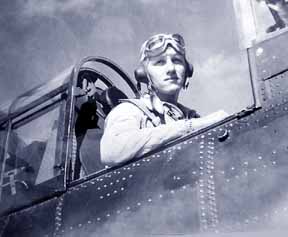
Webmaster: After this training, where did you go?
I had ten days leave coming at home then orders to Daytona Beach, Florida for operational training. This was over water training, navigation, bombing, gunnery and general combat.
Webmaster: What type of aircraft were you flying at Daytona Beach?
SBDs [Navy Dive Bombers]. This was my first introduction to combat aircraft. That training was about two to three months and then I was sent to El Toro in California for more training. It was about November of '43 that I was sent overseas and joined a dive bombing squadron in the Marshall Islands. I served with that squadron up and down the Marshalls and Gilbert Islands from Samoa to as far north as Eniwetok. We did submarine searches and hit many radio stations. I spent the full year of 1944 there. On New Years Eve I was in San Francisco celebrating the new year.
Webmaster: After your leave, the war still has eight months to run?
I was ordered to El Toro as an instructor in SB2C's Helldiver.
Webmaster: So you ended up being an instructor after all?
I didn't mind it then. I was slated to go over again fairly soon and I wanted to. They told me I could fly fighters if I went to El Centro, California which was in the middle of the desert. It was a hell hole and didn't appeal to me. They said if I will fly torpedo bombers, they would send me to Santa Barbara so there wasn't much choice. As much as I wanted to fly fighters, El Centro would not be worth it. I went to Santa Barbara and checked out in TBM's. I was assigned to a carrier and was just about to ship out when the war ended.
Webmaster: The war was over in August of 1945, what did you do then?
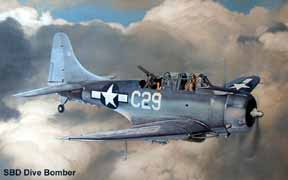
I returned home to complete college.
Webmaster: You left the military?
Yes, but I remained in the reserve.
Webmaster: You went back to Miami University?
No, I went to Ohio State at Columbus because there was a Marine Corps Fighter Squadron there. I was in that all the time I was finishing up college. After I graduated from college, I went to work for Shell Oil. I was with Shell when the Korean thing came up.
Webmaster: What kind of planes did this Marine Corps Reserve Fighter Squadron have?
Primarily F4U's [Corsair] but also some F6F's [Hellcat]. There were also SNJ's for training.
Webmaster: Did you get F6F time also?
Yes, quite a bit. I had checked out in Corsairs during World War II but did not fly them during the war.
Webmaster: During those years in the reserves, you had time in both Corsairs and Hellcats, you must have developed an opinion as to the difference. Which one did you prefer?
I could do most anything with either. All my time in college, I arranged my schedule so I was free most afternoons. This allowed me to go out to the reserve base and fly several hours a day and I did.
Webmaster: You really loved flying?
Oh! Yes, I really did. And to have the opportunity to fly either one of those aircraft as much as I wanted. I also had the opportunity to fly SB2C's and TBM Turkeys but I preferred the fighters particularly the F4U. It was a little more maneuverable and a little faster and easier on the controls than the F6F. Both were excellent aircraft.
Webmaster: This is going on during 1947, 1948 and 1949?
Yes, and into 1950 then the Korean thing came out. We were alerted two or three times, "you are going," "you're not going," "you are going." Then finally we did go.
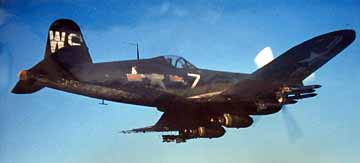
Webmaster: This was sometime in 1950?
No, early 1951. They sent us to Cherry Point, North Carolina for training. I started flying F7F's [Tigercat] as a photo pilot. I didn't want to be a photo pilot but I did like the F7F.
The day we landed in Korea, they asked if anyone wanted to fly Corsairs. They had two fighter squadrons that needed pilots so up went my hand. A buddy and I who had flown together for many years elected to go. We joined VMF323 and went to airfield K1 near Pusan. We were flying missions all the way up to the Yalu.
Webmaster: Mostly ground support?
Interdiction and ground support. The rest was close air support with the Marine Corps. After about two months we moved up to K18 which was on the east coast of Korea close to the front lines. Primary mission was close air support. We flew one or two missions a day fairly regularly. We carried quite a load. Napalm on the center rack, two-one thousand pounders and a full load of rockets on the wings. You can see these in the picture of number 7. This particular time, I had no napalm aboard. That picture shows what the plane looked like in combat. They were all covered with mud, dirt and dust. The main thing is we never had an engine failure.
The mechanics worked like mad in all kinds of weather. They wallowed in the mud working on the planes keeping them flying. Marine Corps air mechanics were the best and that is one thing I really appreciated about the Corps.
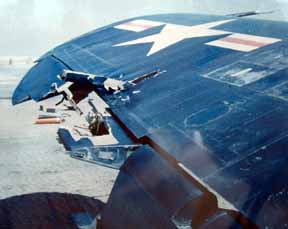
Webmaster: Reflecting on what the Marine mechanics accomplished on Wake Island and Guadalcanal, we could not have had the victories without them. Those 16 days we held the Japanese fleet at bay on Wake was a victory of sorts.
You can't believe how proud we were of those people. They never got any recognition outside of the squadron. We got all the ribbons but they were doing far more than we were.
Webmaster: The Korean War ended in May of 1953. Were you still flying those support missions when the war ended?
The Marines moved from the east coast to the west coast during the latter part of the war. We were stationed at K6 south of Seoul.
Webmaster: Did the Chosin Reservoir incident happen while you were in Korea?
No, this was after that. That happened early in 1950. We were up over the Chosin often hitting the Chinese. I finished my tour at K6 and that was it. I came back to El Toro.
Webmaster: Did you stay in the Marines?
No, I went back to Shell Oil in Ohio. I worked there for six months but after Korea, it was so tame. I became frustrated. About that time, I received a letter from the Marine Corps asking me if I wanted a regular commission. I talked it over with my wife and she said, "Whatever you want to do." She was a school teacher at the time.
I hemmed and hawed for a few days and said, "how can I lose?"
Webmaster: You were a reserve captain at the time?
Yes, and they said they would make it a regular commission. So I accepted. We went to Quantico, Virginia for some courses and I was in the development area. We were then assigned to Twenty-Nine Palms and later to Hawaii and back to Quantico. Then I retired.
Webmaster: Did you have twenty years in by then?
Counting my reserve time, I did.
Webmaster: What rank were you when you retired?
Major.
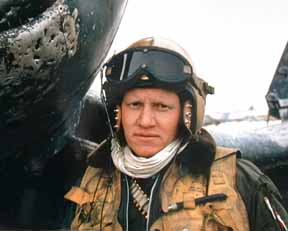
Webmaster: The damage to your Corsair during those Korean missions, as seen in these pictures, didn't seem to prevent you from returning to base. How can that be?
I think in five missions, I had ailerons torn off. I really didn't have any trouble at all even though I got hit on about every third mission. I flew 153 missions during that war. During World War II, I flew 100 missions and only got hit three times. Of course in WWII, we flew mostly over water and would come under fire only during the actual attack of the target. In Korea, we were being shot at all the time.
Webmaster: During World War II in your SBD, did you ever make an attack on a ship?
No large ships but some small fishing ships. We always hit Japanese airfields on the islands.
Webmaster: Describe that one incident where you, early on, forgot to deploy your dive brakes during an attack on a Japanese installation.
It happened to other pilots also. I only did it once early in my combat experience in the Pacific. The squadron would approach the target and we would be lined up. The leader would call off that he was going in and we would roll off, one after another. We were supposed to open the dive brakes as we started our roll. By the time I realized it, I was afraid of popping my dive brakes in fear of tearing them off. I was the first to reach the target and I dropped my bombs earlier than normal and pulled out. The old man was screaming at me, "What the hell are you doing down there?" During a normal dive, we reached about 275 miles an hour but I exceeded 400 mph that time. I pulled out OK--way ahead of everyone of course.
Webmaster: What altitude did you normally start your dive?
Anywhere from 12,000 to 16,000 feet depending on anti-aircraft fire.
Webmaster: When you entered your dive, was it vertical or at an angle?
Mostly at an angle. 70 to 85 degrees was normal.
Webmaster: What altitude would you reach upon release of the bombs?
From fifteen hundred feet down to eight hundred feet? You had better be pulling out by eight hundred feet. At this point, you retracted your dive brakes and your airspeed shot up.
Webmaster: Once you leveled out, how far above the water were you?
From several hundred feet to right on the water. Most of the islands we hit were flat and right at sea level.
Webmaster: Thanks for all your good information. I have learned a lot from this interview. And thanks mostly for your service to our country--in your case for two wars.
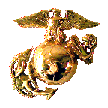



|